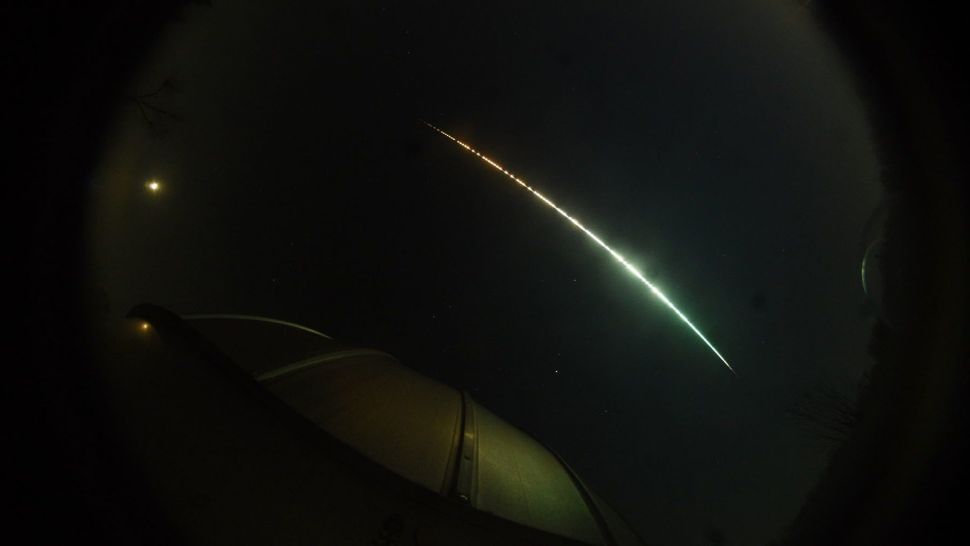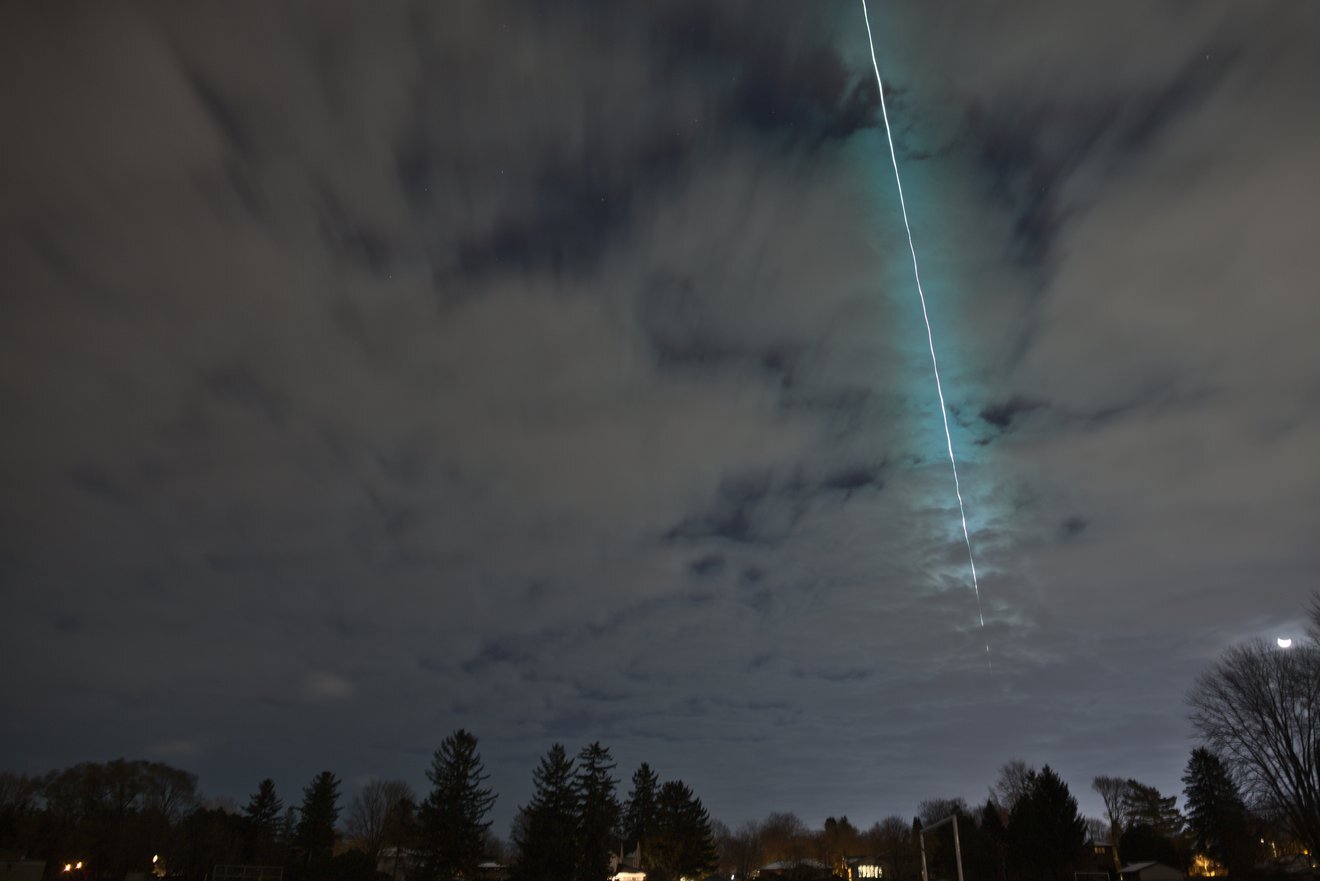23.11.2022
The space rock was only the sixth ever spotted just before falling to Earth.

A timelapse image of a fireball event over Canada on Nov. 19 from start to finish. (Image credit: Western Meteor Group)
A small space rock was detected just a few hours before hitting Earth's atmosphere and landing in Canada's Lake Ontario on Saturday (Nov. 19).
The mini-asteroid, less than 3 feet (1 meter) wide, was spotted by astronomer David Rankin at Mount Lemmon Observatory in Arizona, according to SpaceWeather.com(opens in new tab). Subsequent observations by other astronomers confirmed that the rock, coming from the direction of the main asteroid belt between the orbits of Mars and Jupiter, was on a collision course with Earth.
Only three hours after the first detection, the object, since dubbed C8FF042, sliced through the sky above Canada and landed in Lake Ontario, according to NASA(opens in new tab).
According to the European Space Agency (ESA), this was only the sixth case of an asteroid being found just before impact. In March, a Hungarian astronomer detected a somewhat bigger space rock only two hours before it burned up above the northern Atlantic Ocean.
Eyewitnesses from Toronto and around reported seeing the bright fireball, which lit up the sky on Saturday at about 3:27 EST (0827 GMT). Many meteor and web cameras captured views of the fireball; One stunning video sequence shows the streak of light passing behind Toronto's iconic CN Tower.
According to NASA, radar stations tracked the meteorite from the altitude of about 9 miles (15 kilometers) to 0.53 miles (0.850 km), where it likely fragmented. Space agency officials wrote that most of the fragments probably fell into Lake Ontario, with some small pieces possibly landing near the towns of Grimsby and McNab. The American Meteor Society(opens in new tab) has received 59 reports of fireball sightings.
Small asteroids cross the path of our planet frequently. The smallest ones usually burn up in Earth's atmosphere, leaving behind only the ephemeral light streaks. Fragments of larger rocks can reach Earth as precious meteorites that scientists can study to get a glimpse of the nature of objects in the solar system.
Bigger rocks, over 65 feet wide (20 m), can cause problems on Earth as the shockwaves their explosions trigger can shatter windows and knock down trees. Larger asteroids can be even more damaging, but the impacts of those are fortunately very rare.
Eyewitnesses from Toronto and around reported seeing the bright fireball, which lit up the sky on Saturday at about 3:27 EST (0827 GMT). Many meteor and web cameras captured views of the fireball; One stunning video sequence shows the streak of light passing behind Toronto's iconic CN Tower.
According to NASA, radar stations tracked the meteorite from the altitude of about 9 miles (15 kilometers) to 0.53 miles (0.850 km), where it likely fragmented. Space agency officials wrote that most of the fragments probably fell into Lake Ontario, with some small pieces possibly landing near the towns of Grimsby and McNab. The American Meteor Society(opens in new tab) has received 59 reports of fireball sightings.
Small asteroids cross the path of our planet frequently. The smallest ones usually burn up in Earth's atmosphere, leaving behind only the ephemeral light streaks. Fragments of larger rocks can reach Earth as precious meteorites that scientists can study to get a glimpse of the nature of objects in the solar system.
Bigger rocks, over 65 feet wide (20 m), can cause problems on Earth as the shockwaves their explosions trigger can shatter windows and knock down trees. Larger asteroids can be even more damaging, but the impacts of those are fortunately very rare.
Quelle: SC
+++
NASA Program Predicted Impact of Small Asteroid Over Ontario, Canada

This time-lapse photograph was taken by astronomer Robert Weryk from near his home in London, Ontario, Canada, after NASA’s Scout system forewarned him about the entry of 2022 WJ1 on Nov. 19, 2022. The resulting fireball streaked directly overhead and continued east until it broke up.
2022 WJ1 was a tiny asteroid on a collision course with Earth. But astronomers saw it coming, and NASA’s Scout impact hazard assessment system calculated where it would hit.
In the early hours of Saturday, Nov. 19, the skies over southern Ontario, Canada, lit up as a tiny asteroid harmlessly streaked across the sky high in Earth’s atmosphere, broke up, and likely scattered small meteorites over the southern coastline of Lake Ontario. The fireball wasn’t a surprise. Roughly 1 meter (3 feet) wide, the asteroid was detected 3 ½ hours before impact, making this event the sixth time in history a small asteroid has been tracked in space before impacting Earth’s atmosphere.
NASA is tasked with the detection and tracking of much larger near-Earth objects that could survive passage through Earth’s atmosphere and cause damage on the ground, but those objects can also be detected much further in advance than small ones like the asteroid that disintegrated over southern Ontario. Such small asteroids are not a hazard to Earth, but they can be a useful test for NASA’s planetary defense capabilities for discovery, tracking, orbit determination, and impact prediction.
“The planetary defense community really demonstrated their skill and readiness with their response to this short-warning event,” said Kelly Fast, Near-Earth Object Observations program manager for the Planetary Defense Coordination Office (PDCO) at NASA Headquarters in Washington. “Such harmless impacts become spontaneous real-world exercises and give us confidence that NASA’s planetary defense systems are capable of informing the response to the potential for a serious impact by a larger object.”
The asteroid was discovered by the NASA-funded Catalina Sky Survey, which is headquartered at the University of Arizona in Tucson, on the evening of Nov. 18 during routine search operations for near-Earth objects. The observations were quickly reported to the Minor Planet Center (MPC) – the internationally recognized clearinghouse for the position measurements of small celestial bodies – and the data was then automatically posted to the Near-Earth Object Confirmation Page.
NASA’s Scout impact hazard assessment system, which is maintained by the Center for Near Earth Object Studies (CNEOS) at the agency’s Jet Propulsion Laboratory in Southern California, automatically fetched the new data from that page and began calculating the object’s possible trajectory and chances of impact. CNEOS calculates every known near-Earth asteroid orbit to provide assessments of potential impact hazards in support of NASA’s PDCO.
A 3D model of asteroid 2022 WJ1 can be viewed in the fully interactive Eyes on Asteroids, including its orbit around the Sun until it impacted the atmosphere over southern Ontario, Canada. Zoom out and use the fast-forward and rewind controls to follow the asteroid’s journey. Credit: NASA/JPL-Caltech
Seven minutes after the asteroid was posted on the confirmation page, Scout had determined it had a 25% probability of hitting Earth’s atmosphere, with possible impact locations stretching from the Atlantic Ocean off the East Coast of North America to Mexico. More observations were then provided by the astronomical community, including amateur astronomers in Kansas, to better refine the asteroid’s trajectory and possible impact location.
“Small objects such as this one can only be detected when they are very close to Earth, so if they are headed for an impact, time is of the essence to collect as many observations as possible,” said Shantanu Naidu, navigation engineer and Scout operator at JPL. “This object was discovered early enough that the planetary defense community could provide more observations, which Scout then used to confirm the impact and predict where and when the asteroid was going to hit.”
As Catalina continued to track the asteroid over the next few hours, Scout used this new data to continually update the asteroid’s trajectory and the system’s assessment of the chance of impact, posting those results on the hazard-assessment system’s webpage.
Community Effort
Many astronomers check the Scout webpage throughout the night to determine the most important asteroids to track. A group of amateur astronomers at Farpoint Observatory in Eskridge, Kansas, tracked the asteroid for more than an hour, providing critical additional data that enabled Scout to confirm a 100% impact probability and determine the expected location of atmospheric entry as being over southern Ontario at 3:27 a.m. EST (12:27 a.m. PST) Nov. 19. With more than two hours remaining before impact, there was time to alert scientists in southwestern Ontario of the bright fireball that would occur.
A total of 46 observations of the asteroid’s position were ultimately collected, the final one being made only 32 minutes before impact by the University of Hawaii 88-inch (2.2-meter) telescope on Mauna Kea.
As predicted, at 3:27 a.m. EST (12:27 a.m. PST), the asteroid streaked through Earth’s atmosphere at a shallow angle and broke up, likely producing a shower of small meteorites and leaving no reported damage on the surface. After this harmless disintegration, the Minor Planet Center designated the asteroid 2022 WJ1 to acknowledge its discovery while still in space.
Dozens of sightings were reported to the American Meteor Society, and scientists who were alerted to the Scout prediction were able to photograph the asteroid’s atmospheric entry. Videos of the fireball collected by the public were also posted online. NASA’s Meteorite Falls website also reported weather radar detections of fragments of the fireball falling as meteorites at the predicted time over Lake Ontario. Small meteorites might be found east of the town of Grimsby while larger meteorites might be nearer the town of McNab.
The first asteroid to be discovered and tracked well before hitting Earth was 2008 TC3, which entered the atmosphere over Sudan and broke up in October 2008. That 13-foot-wide (4-meter-sized) asteroid scattered hundreds of small meteorites over the Nubian Desert. Earlier this year, asteroid 2022 EB5 entered the atmosphere over the Norwegian Sea after Scout accurately predicted its location, becoming the fifth object to be detected before impact. As surveys become more sophisticated and sensitive, more of these harmless objects are being detected before entering the atmosphere, providing real exercises for NASA’s planetary defense program.
More information about CNEOS, asteroids, and near-Earth objects can be found at:
https://www.jpl.nasa.gov/asteroid-watch
Quelle: NASA
